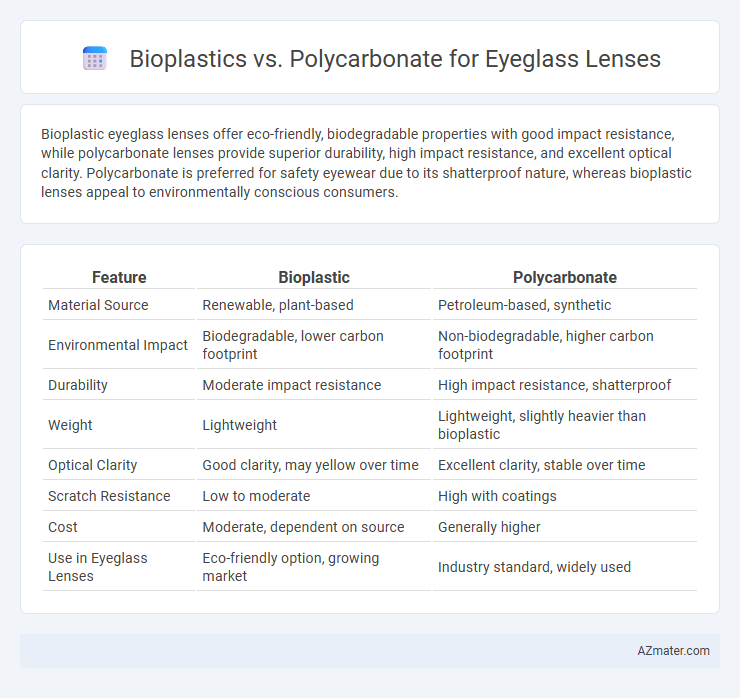Bioplastic eyeglass lenses offer eco-friendly, biodegradable properties with good impact resistance, while polycarbonate lenses provide superior durability, high impact resistance, and excellent optical clarity. Polycarbonate is preferred for safety eyewear due to its shatterproof nature, whereas bioplastic lenses appeal to environmentally conscious consumers.
Table of Comparison
| Feature | Bioplastic | Polycarbonate |
|---|---|---|
| Material Source | Renewable, plant-based | Petroleum-based, synthetic |
| Environmental Impact | Biodegradable, lower carbon footprint | Non-biodegradable, higher carbon footprint |
| Durability | Moderate impact resistance | High impact resistance, shatterproof |
| Weight | Lightweight | Lightweight, slightly heavier than bioplastic |
| Optical Clarity | Good clarity, may yellow over time | Excellent clarity, stable over time |
| Scratch Resistance | Low to moderate | High with coatings |
| Cost | Moderate, dependent on source | Generally higher |
| Use in Eyeglass Lenses | Eco-friendly option, growing market | Industry standard, widely used |
Introduction to Eyeglass Lens Materials
Bioplastic and polycarbonate are two prominent materials used for eyeglass lenses, each offering unique benefits in terms of durability and optical clarity. Bioplastic lenses are derived from renewable plant-based sources, providing lightweight, eco-friendly options with good impact resistance. Polycarbonate lenses, known for their high impact resistance and UV protection, remain a popular choice for safety glasses and sports eyewear, balancing strength and optical performance.
What is Bioplastic?
Bioplastic is a sustainable material derived from renewable biological sources such as corn starch, sugarcane, or cellulose, offering a biodegradable alternative to traditional petroleum-based plastics. In eyeglass lenses, bioplastics provide lightweight, eco-friendly options that reduce environmental impact without compromising optical clarity. These materials contrast with polycarbonate lenses, which are durable, impact-resistant, and made from synthetic polymers but lack biodegradability.
What is Polycarbonate?
Polycarbonate is a durable, impact-resistant thermoplastic widely used for eyeglass lenses due to its high optical clarity and lightweight properties. It offers superior protection against UV rays and is less prone to shattering compared to traditional glass lenses, making it ideal for safety and sports eyewear. Polycarbonate lenses also provide excellent scratch resistance when coated, enhancing their longevity and visual performance.
Environmental Impact: Bioplastic vs Polycarbonate
Bioplastic eyeglass lenses offer a significant environmental advantage over polycarbonate by being derived from renewable resources and exhibiting greater biodegradability, which reduces landfill waste and pollution. Polycarbonate lenses, made from petroleum-based plastics, present challenges due to their non-biodegradable nature and higher carbon footprint in production. The choice between bioplastic and polycarbonate lenses directly impacts sustainability efforts in eyewear manufacturing, favoring bioplastics for eco-conscious consumers seeking greener alternatives.
Optical Clarity and Visual Performance
Bioplastic eyeglass lenses offer high optical clarity with reduced chromatic aberration, enhancing visual performance through lightweight and impact-resistant properties. Polycarbonate lenses excel in durability and UV protection but may exhibit slight compromises in optical sharpness due to inherent material refractive index variations. Choosing between bioplastic and polycarbonate depends on prioritizing optical precision versus impact resistance for optimal vision correction.
Durability and Scratch Resistance
Bioplastic eyeglass lenses offer excellent impact resistance and flexibility but tend to be less durable than polycarbonate lenses, which provide superior scratch resistance and long-lasting clarity due to their harder surface. Polycarbonate lenses are engineered to withstand daily wear and tear, making them ideal for users seeking robust protection against scratches and cracks. While bioplastic lenses prioritize comfort and environmental benefits, polycarbonate remains the preferred choice for durability and scratch-resistant performance in eyewear.
Weight and Comfort Comparison
Bioplastic eyeglass lenses typically weigh less than polycarbonate lenses, enhancing comfort during extended wear. The lower density of bioplastic reduces pressure on the nose and ears, making it ideal for users seeking lightweight eyewear. Polycarbonate lenses, while durable and impact-resistant, often feel heavier, which can lead to discomfort in prolonged use.
Cost and Affordability
Bioplastic eyeglass lenses typically offer a more affordable option compared to polycarbonate, making them popular for budget-conscious consumers. Polycarbonate lenses, while more expensive, provide superior impact resistance and durability, justifying the higher cost for active lifestyles or safety needs. Cost differences between the two materials can influence purchasing decisions based on the balance between budget constraints and desired lens performance.
Safety and Biocompatibility
Bioplastic eyeglass lenses offer superior biocompatibility, reducing risks of allergic reactions and skin irritations compared to polycarbonate lenses, which may contain BPA and other chemical additives. Polycarbonate lenses are impact-resistant and shatterproof, providing enhanced safety against physical trauma, but their chemical composition raises concerns for long-term exposure. Bioplastic materials, often derived from renewable resources, ensure safer wear for sensitive individuals while maintaining adequate durability for everyday use.
Future Trends in Eyeglass Lens Materials
Bioplastic eyeglass lenses are gaining traction due to their biodegradability and renewable sourcing, aligning with eco-conscious consumer demands and regulatory pressures for sustainable materials. Polycarbonate lenses maintain popularity for their impact resistance and lightweight properties, driving innovation in coatings and hybrid composites to enhance optical clarity and durability. Emerging trends indicate a shift toward integrating nanotechnology and bio-based polymers to create lenses that combine environmental benefits with superior performance features.

Infographic: Bioplastic vs Polycarbonate for Eyeglass Lens
 azmater.com
azmater.com